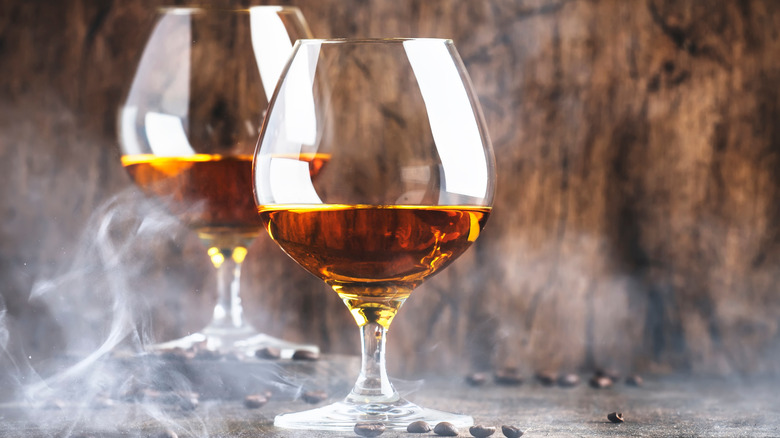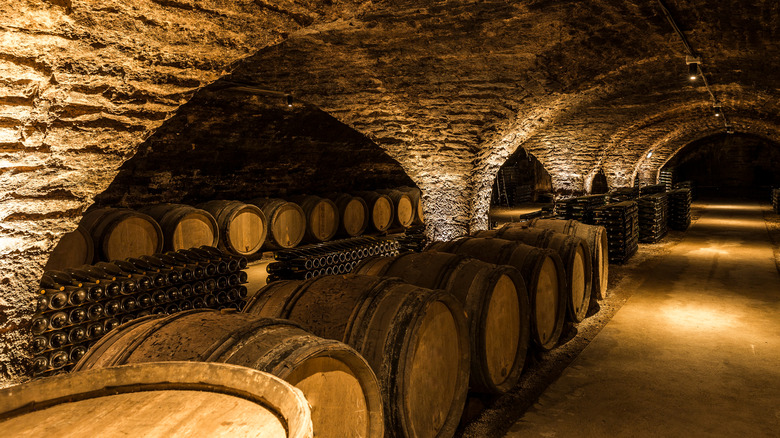What Is Armagnac, And What Does It Taste Like?
Over 700 years ago, the French Cardinal Vital du Four wrote a treatise entitled "A very useful book to conserve your health and stay on top form." As described in Domaine a Lafitte, he extolled the curative powers of "Burning Water" or "Water of Immortality." Per Brandy Classics, this marked the dawn of drinking armagnac, the oldest known spirit, and France's first brandy. Kept in casks, the liquid began to take on a pleasing, flavorful taste and was consumed for both therapy and enjoyment.
Armagnac germinated from the contributions of three cultures. History credits the Romans with introducing the grapevine. The still is an Arabic invention, and the Celts devised the barrel. History also attributes the brandy's name to Hermann, a revered knight in the present-day Gascony region of France, where the spirit is grown, distilled, and aged. His name was Arminius in Latin, which became Armagnac in the local dialect.
Today, the brandy is produced only in three sub-regions of Gascony, per a 1909 decree. They are Bas Armagnac, the primary source, Armagnac-Tenareze, and Haut Armagnac. It was celebrated in the novel The Three Musketeers; one of the protagonists was from Gascony, and the Company of Armagnac Musketeers continues to promote armagnac and the region. It is frequently mentioned in the same breath as a similar spirit, cognac. However, New York Magazine considers armagnac to be far superior, and it is less expensive.
Brandy derived from continuous distillation
According to Chateau Arton, armagnac is the product of a continuous distillation process using white wine grapes, primarily the Ugni Blanc variety. The liquid (eaux-de-vie at this stage) is perpetually heated, then aged for at least two years in barrels made from locally grown oak. No other liquor can be stored in the casks prior to the armagnac. Some vintages are derived from an individual batch, while others are a blend of several. Armagnac is more artisanal and less commercial than cognac, as it is made in much smaller quantities on small farms, with less of it exported. Armagnac also has a lower alcohol content than its cognac relative.
MasterClass defines four grades of armagnac. Very Special (V.S.) is the youngest variety. Very Superior Old Pale (V.S.O.P.) is aged at least four years. Napoleon Armagnac, also known as Extra Old (X.O.), sits in the cask for at least six years, and Hors d'age ("Beyond age") is cured for at least 10. Some armagnacs contain vintages that are even more than a century old. The Los Angeles Times reported that a vintage 1911 bottle of armagnac was recently up for sale, and the list price was $4,500. Generally, however, the younger brandies are relatively comparable in price to other quality liquors, and aged armagnac is similar to premium whiskeys.
A unique abundance of flavors
As armagnac ages, it darkens, thickens, and various flavors emerge. There are as many as 100 of them, encompassing 13 classes of aromas. Armagnac's initial flavors are fruity, described by Appreciate as redolent of prunes, quince, figs, and apricots. As the brandy ages, it develops a deeper, more floral taste with a fruity essence that is more concentrated. Very old armagnac develops a woody, meaty aroma with elements of aged leather and tobacco. It is suggestive of rancio charentais, the complex, nutty aromas and flavors characteristic of extremely vintage armagnacs or cognacs.
The richness of armagnac makes it a suitable accompaniment to foods such as caviar, foie gras, and lox. It can also be used as a replacement for vinegar in salad dressing. A culinary black mark is its connection to eating the endangered ortolan. The baby birds are marinated in armagnac, then consumed in a single gulp. Gourmets consider it a sublime experience, but Cosmos notes its darker ritualistic aspects. Ortolan eaters traditionally cover their faces with a napkin while consuming the buntings, either to capture the aromas or to symbolically hide their shame.
The full range of armagnac's flavors and aromas can be experienced in a number of ways: Drinking a small glass between dinner courses, as a post-meal liqueur, on the rocks, sugared and set afire, or as a cocktail component.


